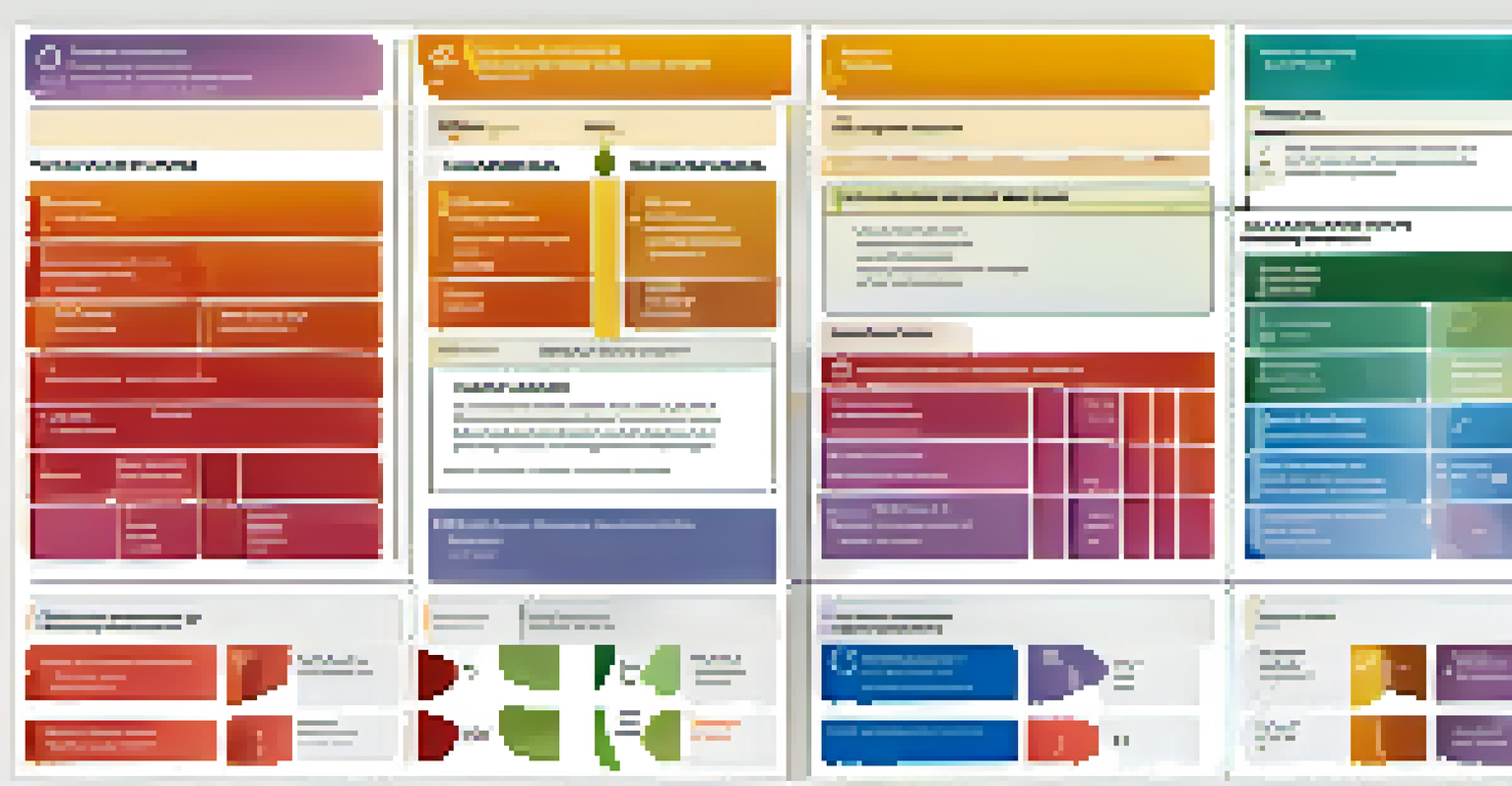Integrating the Business Model Canvas in Strategic Planning

Understanding the Business Model Canvas Framework
The Business Model Canvas (BMC) is a strategic management tool that visually outlines a company's value proposition, infrastructure, customers, and finances. This one-page framework helps businesses clarify their ideas and streamline their strategies. By breaking down complex business models into nine essential components, it provides a clear snapshot of how a business operates.
Strategic planning is not just about making plans; it's about making plans that will actually be implemented.
Each segment of the BMC, from customer segments to cost structure, plays a crucial role in understanding the overall business landscape. For example, identifying customer segments allows a company to tailor its marketing efforts effectively. This clarity helps businesses make informed decisions that align with their strategic goals.
Ultimately, the BMC serves as a roadmap for both new and existing businesses. It encourages teams to visualize their business model and identify areas for improvement or innovation. This visual representation makes it easier to communicate ideas across departments and ensures everyone is on the same page.
The Role of Strategic Planning in Business Success
Strategic planning is the process of defining a company's direction and making decisions on allocating resources to pursue this strategy. It involves setting goals, determining actions to achieve those goals, and mobilizing resources to execute the actions. A well-structured strategic plan lays the foundation for a business's long-term success.

Without effective strategic planning, businesses may drift aimlessly, missing opportunities for growth and innovation. For instance, a startup might fail to recognize a lucrative market segment simply because it hasn’t outlined its strategic objectives clearly. This is where integrating the BMC can make a significant difference.
BMC Clarifies Business Strategies
The Business Model Canvas simplifies complex business models into nine components, providing a clear overview of a company's operations.
Moreover, strategic planning helps businesses anticipate potential challenges and devise contingency plans. By regularly reviewing and adjusting their strategies, companies can stay agile and responsive to market changes. This adaptability is crucial for thriving in today's fast-paced business environment.
How to Integrate the BMC into Your Strategic Planning Process
Integrating the Business Model Canvas into your strategic planning process begins with gathering your team for a brainstorming session. Start by filling out each of the nine components of the BMC together, encouraging open discussion. This collaborative approach fosters creativity and ensures that everyone has a voice in shaping the business's direction.
A business model describes the rationale of how an organization creates, delivers, and captures value.
After completing the BMC, use it as a foundation to develop your strategic plan. Identify key objectives that align with the value propositions and customer segments outlined in the canvas. For example, if your BMC highlights a new target market, your strategic plan should include specific marketing objectives to engage that audience.
Regularly revisiting the BMC during your strategic planning sessions allows you to adjust your strategies as needed. This ongoing integration ensures that your business remains focused on its core value and adapts to any shifts in the market landscape. By treating the BMC as a living document, you can keep your strategic plan relevant and impactful.
Benefits of Using the BMC in Strategic Planning
Using the Business Model Canvas in your strategic planning offers numerous benefits, one of which is enhanced clarity. The visual format of the BMC helps teams easily grasp complex business concepts, making discussions more productive. This clarity promotes a shared understanding among team members, leading to a more cohesive approach to strategy.
Additionally, the BMC encourages a more innovative mindset by prompting teams to explore new opportunities. By challenging existing assumptions and exploring different customer segments or value propositions, businesses can uncover untapped markets. This proactive approach to innovation is crucial for staying competitive.
Strategic Planning Drives Success
Effective strategic planning helps businesses define their direction and allocate resources wisely to seize growth opportunities.
Moreover, the BMC's structured nature helps prioritize initiatives based on their potential impact. Teams can assess which components of the business model require immediate attention or resources, leading to more efficient strategic planning. This prioritization ultimately drives better outcomes and supports sustainable growth.
Real-World Examples of BMC Integration
Many successful companies have effectively integrated the Business Model Canvas into their strategic planning processes. For instance, Airbnb used the BMC to redefine its value proposition and target customer segments, leading to rapid growth in a competitive market. By clearly outlining its business model, Airbnb was able to align its efforts and innovate continuously.
Another example is the coffee giant Starbucks, which utilized the BMC to evaluate its customer relationships and channels. By focusing on creating a unique customer experience, Starbucks differentiated itself from competitors and built a loyal customer base. The insights gained from the BMC helped Starbucks maintain its brand identity while expanding globally.
These examples illustrate how leveraging the BMC can lead to strategic advantages. By clearly visualizing their business models, these companies made informed decisions that propelled their growth and profitability. Such success stories demonstrate the power of integrating the BMC into strategic planning.
Common Challenges in BMC Integration
While integrating the Business Model Canvas into strategic planning offers many benefits, it’s not without its challenges. One common issue is resistance to change; team members may be hesitant to adopt new methods or rethink established processes. Overcoming this resistance requires effective communication and a demonstration of the BMC's value to the organization.
Another challenge is ensuring that the BMC remains relevant over time. As businesses evolve, their models may need adjustments, and failing to update the BMC can lead to misalignment with the strategic plan. Regular reviews and updates are essential to keep the canvas aligned with current goals and market conditions.
Collaboration Enhances BMC Integration
Involving diverse team members in the BMC process fosters creativity and ensures that all perspectives contribute to shaping the business model.
Lastly, teams may struggle with collaboration during the BMC integration process. Different perspectives can lead to conflicting ideas, making it difficult to reach consensus. Encouraging open dialogue and fostering a collaborative environment can help mitigate this issue, ensuring that all voices are heard and valued.
Best Practices for Successful BMC Implementation
To ensure successful implementation of the Business Model Canvas in your strategic planning, start by involving diverse team members in the process. This inclusion brings different perspectives and expertise to the table, enriching the canvas with valuable insights. Additionally, consider using digital tools to create and share the BMC, making it easily accessible for all team members.
Regular workshops can help maintain momentum and engagement with the BMC. These sessions allow teams to revisit and refine their business models continually, fostering a culture of innovation. For instance, scheduling quarterly reviews can help identify any necessary adjustments and keep everyone aligned with the strategic plan.

Lastly, don’t be afraid to iterate. The BMC should serve as a dynamic tool that evolves with your business. By embracing a mindset of continuous improvement and being open to feedback, you can maximize the effectiveness of the BMC in your strategic planning efforts.